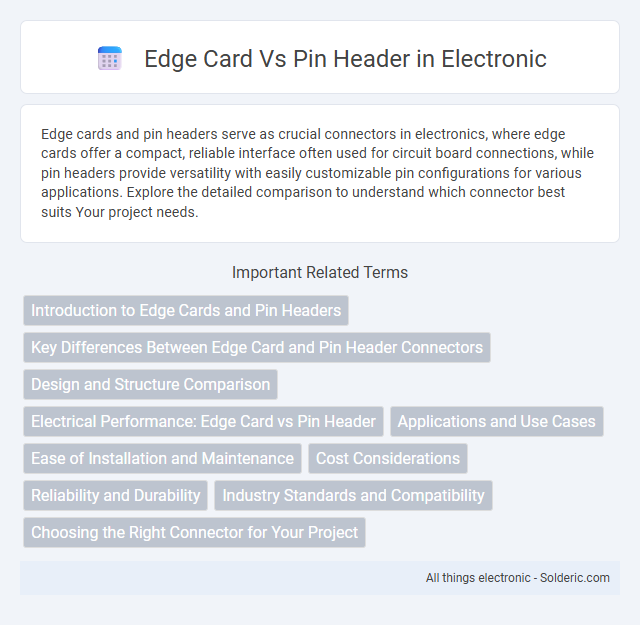Edge cards and pin headers serve as crucial connectors in electronics, where edge cards offer a compact, reliable interface often used for circuit board connections, while pin headers provide versatility with easily customizable pin configurations for various applications. Explore the detailed comparison to understand which connector best suits Your project needs.
Comparison Table
| Feature | Edge Card | Pin Header |
|---|---|---|
| Definition | Connector that mates with a PCB's edge contact pads | Rows of metal pins soldered on PCB for wire or connector attachment |
| Common Use | Expansion cards, memory modules, PCBs in slot connectors | Interfacing wires, jumpers, daughterboards, test points |
| Contact Type | Flat copper pads on PCB edge | Individual metal pins (usually tin or gold-plated) |
| Mechanical Strength | Moderate, relies on friction fit and slot guides | High, secured by solder and optionally screws |
| Signal Integrity | Better for high-speed signals due to short contact length | Good for general purpose, depends on pin quality and layout |
| Installation | Insert PCB edge into card slot | Solder pins or press-fit; can be manually connected |
| Cost | Typically higher due to precise PCB edge processing | Lower cost, mass-produced standard parts |
| Applications | PC expansion, memory cards, plug-in modules | Embedded systems, prototyping, test fixtures |
Introduction to Edge Cards and Pin Headers
Edge cards are circuit board connectors that use the exposed copper traces on the board's edge to establish electrical connections with corresponding slots, providing a compact and efficient interface. Pin headers consist of rows of metal pins soldered onto a PCB, designed to mate with sockets or connectors, commonly used for modular and customizable connections in electronics. Your choice between edge cards and pin headers depends on factors like durability, ease of replacement, and application-specific requirements.
Key Differences Between Edge Card and Pin Header Connectors
Edge card connectors feature a flat, gold-plated PCB edge designed to slot directly into a matching socket, offering high-density connections and reliable signal integrity compared to pin headers. Pin headers consist of rows of metal pins soldered onto a PCB, providing easier assembly and flexibility for modular designs but typically with lower density than edge card connectors. Your choice depends on the application's requirements for durability, connection method, and space constraints.
Design and Structure Comparison
Edge cards feature a flat, PCB-like gold-finger design enabling direct insertion into connectors, optimizing space and signal integrity. Pin headers consist of rows of metal pins protruding perpendicularly from the PCB, facilitating soldered connections with headers or sockets for flexible modularity. The edge card's design offers higher durability and lower contact resistance, while pin headers provide easier repairability and versatile connectivity options.
Electrical Performance: Edge Card vs Pin Header
Edge cards offer superior electrical performance compared to pin headers due to their lower inductance and resistance, resulting in faster signal transmission and reduced signal loss. Pin headers typically have higher contact resistance and are more susceptible to signal degradation at high frequencies, making edge cards ideal for high-speed data applications. You can optimize your system's electrical reliability by selecting edge card connectors when minimizing signal interference and ensuring stable connectivity is critical.
Applications and Use Cases
Edge cards are widely used in applications requiring high-density connections, such as computer motherboards, memory modules, and graphics cards due to their compact design and ability to handle high-speed signals. Pin headers find extensive use in prototyping, embedded systems, and custom electronics where easy connectivity, soldering, and modularity are essential for development and maintenance. Both connectors are critical in electronic device interfacing, with edge cards favored for mass production and pin headers preferred in flexible or low-cost assembly environments.
Ease of Installation and Maintenance
Edge cards offer easier installation with their simple slide-in connection into a corresponding slot, reducing the need for soldering and allowing quick, tool-free replacement. Pin headers require careful alignment and soldering, which can complicate installation and extend maintenance time. For maintenance, edge cards simplify component swaps and troubleshooting, whereas pin headers often necessitate desoldering, increasing labor and potential damage risk.
Cost Considerations
Edge cards typically offer lower manufacturing costs due to simpler PCB design and elimination of soldered pins, reducing assembly labor and materials. Pin headers, while more expensive per unit, provide flexibility and easier troubleshooting, potentially lowering long-term maintenance expenses. Evaluating total cost of ownership involves balancing initial production savings with application-specific durability and serviceability demands.
Reliability and Durability
Edge cards offer enhanced reliability due to their robust gold-plated contacts that ensure consistent electrical connectivity under repeated insertions. Pin headers may face higher wear and oxidation risks over time, potentially leading to less durable connections in harsh environments. For long-term durability, edge cards generally outperform pin headers by maintaining stable performance in high-cycle applications.
Industry Standards and Compatibility
Edge cards follow industry standards such as PCIe and IEEE 802.3, ensuring broad compatibility with motherboards and expansion slots in computing hardware. Pin headers adhere to standardized pin spacing and configurations like 2.54mm pitch, enabling seamless integration with various peripherals and embedded systems. Your choice between edge card and pin header connectors should consider the specific device's compatibility requirements and the standardized interfaces it supports.
Choosing the Right Connector for Your Project
Choosing the right connector for your project depends on factors like space constraints, signal integrity, and assembly method. Edge cards offer high-density connections and easy installation by sliding into a slot, making them ideal for compact, high-speed applications. Pin headers provide versatile, reliable connections with soldered or socketed pins, suitable for prototyping and environments requiring frequent disconnection.
Edge Card vs Pin Header Infographic

 solderic.com
solderic.com